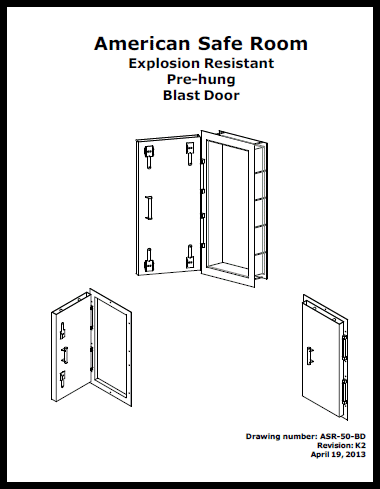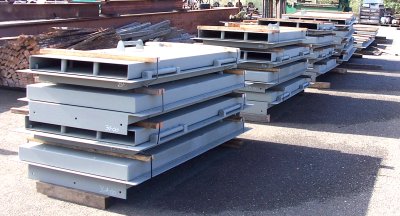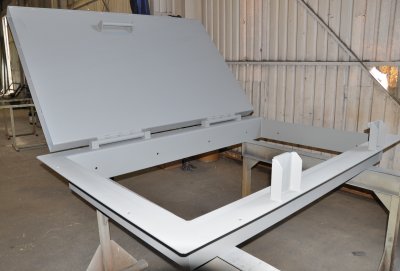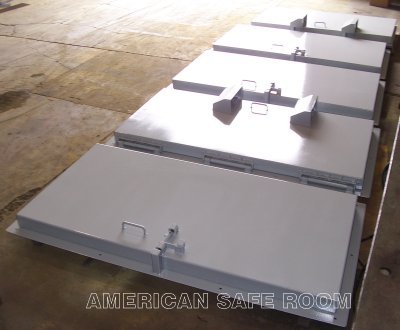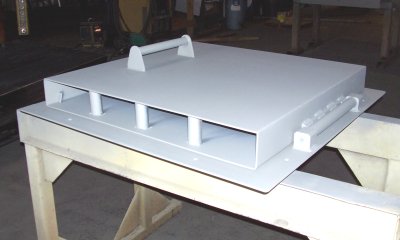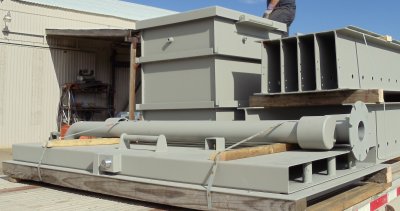
Blast doors - American Safe Room is your complete design,
engineering,
and fabrication solution for blast resistant doors
Looking for a vault door that will lock down your safe room?
See our safe room door over at AmericanSafeRoom.comNeed an engineered blast door for military or industrial applications?
You're at the right place:
Plate steel or fabricated steel single leaf blast resistant doors
with engineer certified UFC-3-340-02 dynamic blast load calculations
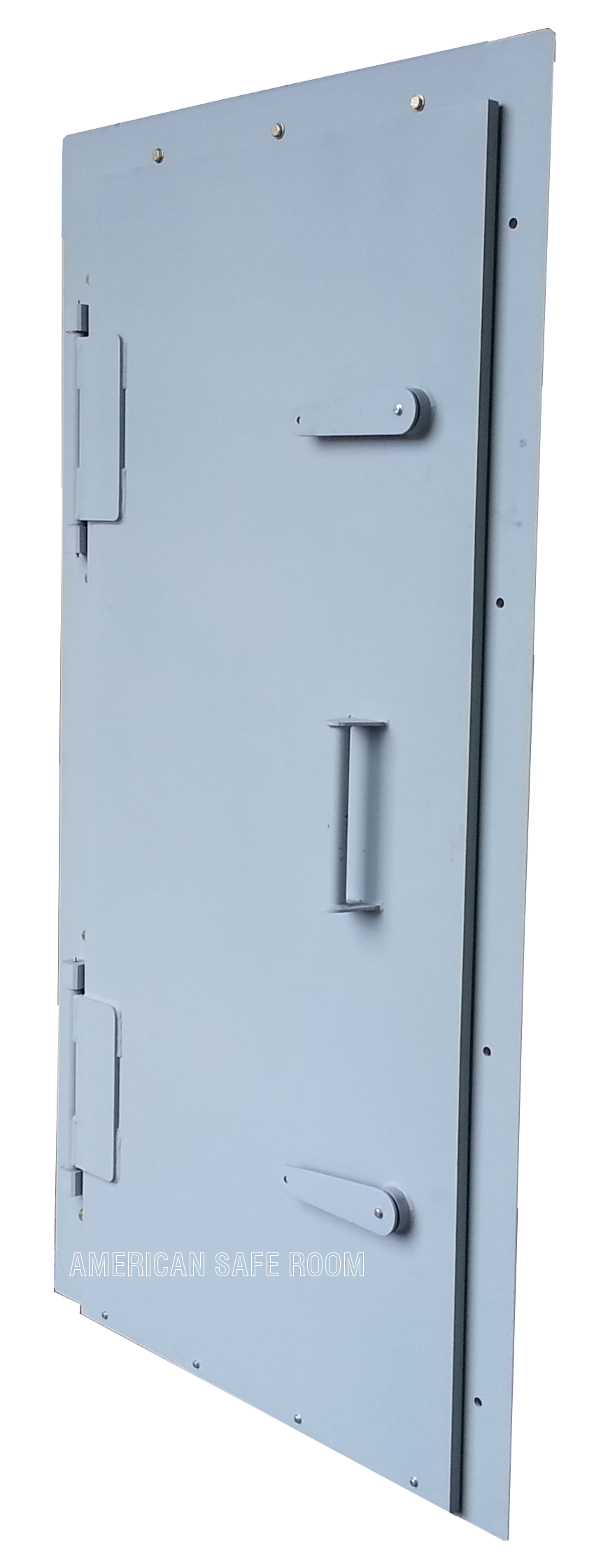 We have supplied plate and fabricated steel single leaf blast doors for a variety of critical applications ranging from nuclear power plants to aerospace industry test cells, foundries, and military munitions bunkers. We work with our customers to ensure that our custom engineered product will meet their needs.
We have supplied plate and fabricated steel single leaf blast doors for a variety of critical applications ranging from nuclear power plants to aerospace industry test cells, foundries, and military munitions bunkers. We work with our customers to ensure that our custom engineered product will meet their needs.
Our doors feature a wide range of proven hardware that can be scaled up or down to meet your requirements. Our high duty-cycle hinges and latches feature oil impregnated bronze sleeve bearings and stainless grease fittings.
We can quickly and easily design doors for your unique triangular or bilinear dynamic blast load specifications.
A triangular blast load is characterized by either the peak pressure (psi) and duration (ms), or by impulse (psi-ms) and either peak pressure or duration.
A bilinear blast load is a combination of two triangular loads resulting from shock pressure and gas pressure.
We complete the initial design and engineering calculations in house and send them out to be reviewed and certified by a professional engineer. All initial design and engineering is done in house, then the design is reviewed by external professional engineers so that we can get stamps in all 50 states and Canada and more.
Be sure and see the suggested specification verbiage for a written description of our plate steel doors.
Concrete filled steel envelope doors
with engineer certified static blast load calculations
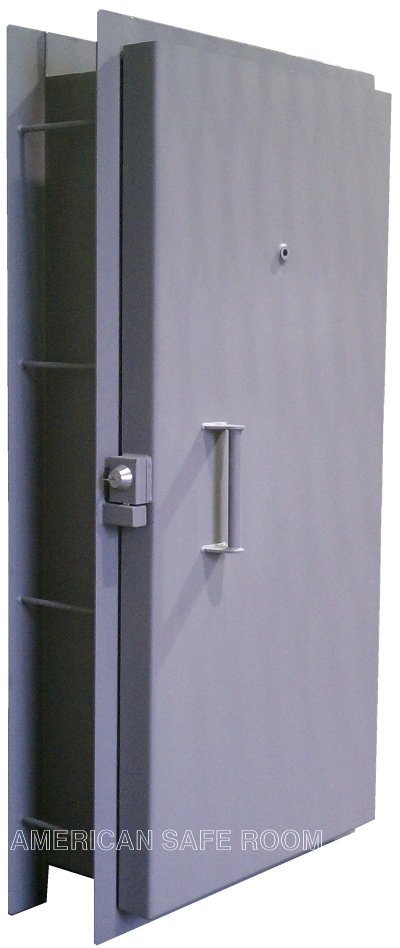 Our concrete filled doors are the best solution for bomb shelters and safe rooms. They are legitimate blast doors, not ornamental "vault style" doors made from sheet metal with fancy paint jobs.
Our concrete filled doors are the best solution for bomb shelters and safe rooms. They are legitimate blast doors, not ornamental "vault style" doors made from sheet metal with fancy paint jobs.
These doors are also very popular for industrial applications - even in low pressure environments. Compared to other manufacturer's 5 to 10 PSI doors, they cost less and have a significant margin of safety!
They have outstanding ballistic properties - UL 752, level 8 compliant (multiple 7.62 NATO ball) and the door leaves cannot be cut with a torch. Add to that our engineer certified 50 PSI blast load rating and you have the perfect bomb shelter door.
The standard construction is 3/16" steel skins with 4" of concrete fill. The door leaf envelope is filled after the door is mounted on the wall.
Mount a 600 pound door and then fill it with concrete to put 1,600 pounds of mass between you and whatever is outside your shelter!
See our standard sizes, prices, and the technical manual in the column to the right >>>
Hardware - hinges and latches
We manufacture a line of heavy duty door hardware that ensure you will have years of trouble-free operation. Our engineers select the hardware set based on the blast load requirements, the rebound response, and the door leaf weight.
 Standard duty hinges
Standard duty hinges
These massive hinges are machined from one and a half inch shafts that capture oil impregnated bronze sleeve bearings that are press fit into steel blocks. They feature grease fittings for ongoing lubrication.
The end blocks have a full strength continuous weld to the frame and the pins are stitch welded to the door leaf to spread the forces over a large area. We use these hinges on door leaves up to 2,200 pounds. They are rated for 60,000 pounds per hinge - and our hinges go up in strength from there:
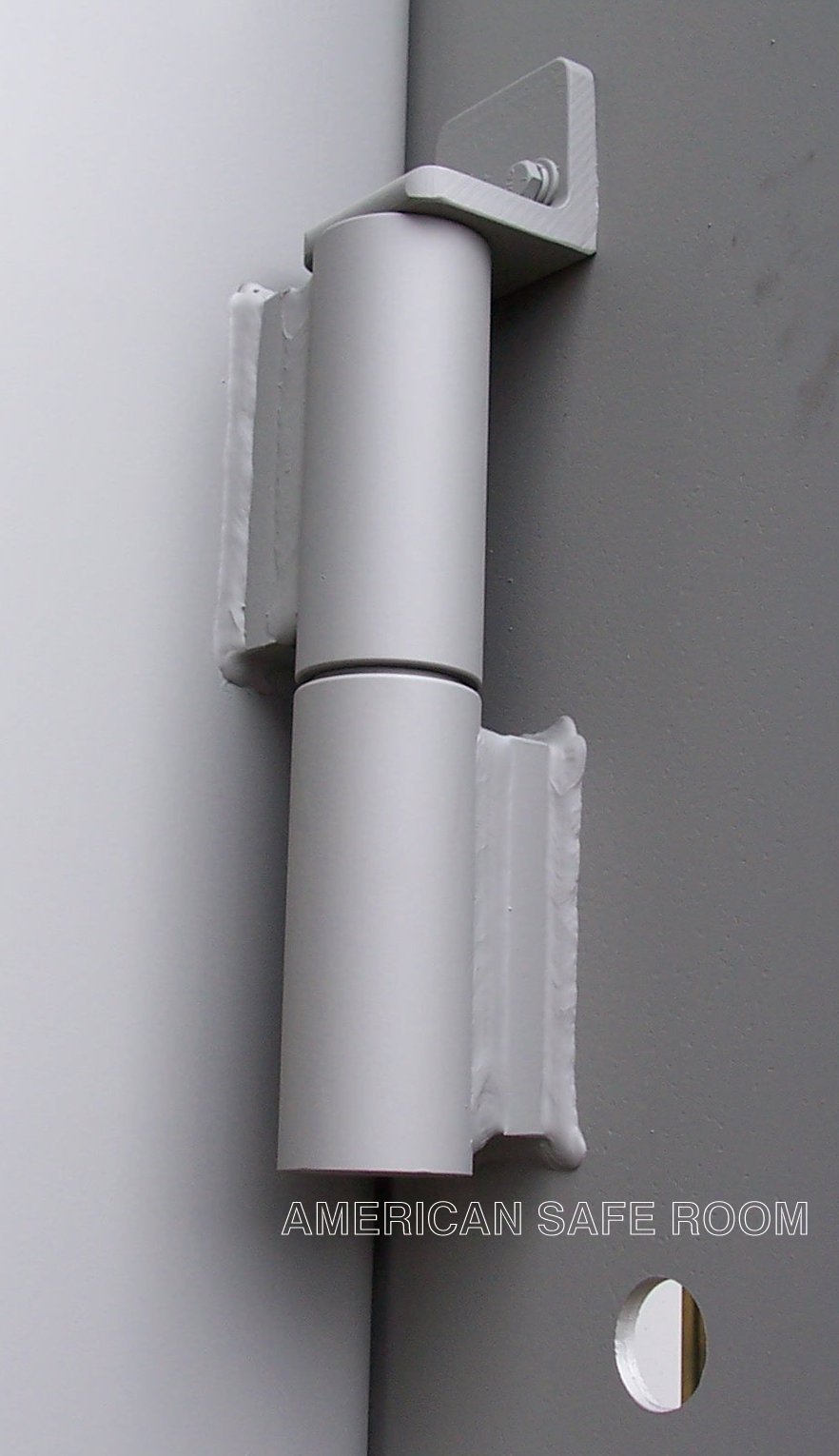 Heavy duty hinges
Heavy duty hinges
These hinges allow the door leaf to be removed from the frame for assembly or repair in the filed. They are machined from 2.375" 1018 cold rolled steel. Both the frame and door leaf have continuous full strength welds.
They feature oil impregnated bronze sleeve bearings that have a flange that bears the thrust load.
We recess the stainless steel grease fitting into the bottom pin. The top pin has the capture bracket. The capture bracket in this picture is bolted on to the frame so the door leaf can be removed if needed.
For high security applications, we weld the capture bracket in place.
See the video below for showing removal and reinstallation of a 6,500 pound 78" x 132" plate steel door leaf with four heavy duty hinges.
 Extreme duty hinges
Extreme duty hinges
We fabricate these hinges from ASTM A572 plate steel. They feature high load oil impregnated bronze alloy sleeve bearings and separate oil impregnated high load bronze alloy thrust bearings.
The pins are machined from two inch 1018 cold rolled steel and are welded in place after the door leaves are installed on the embedded frame. These hinges are suitable for extremely large and heavy door leaves.
See the video below showing a 12.5 foot by 20 foot 7 ton door leaf with these hinges being function tested in our fabrication shop:
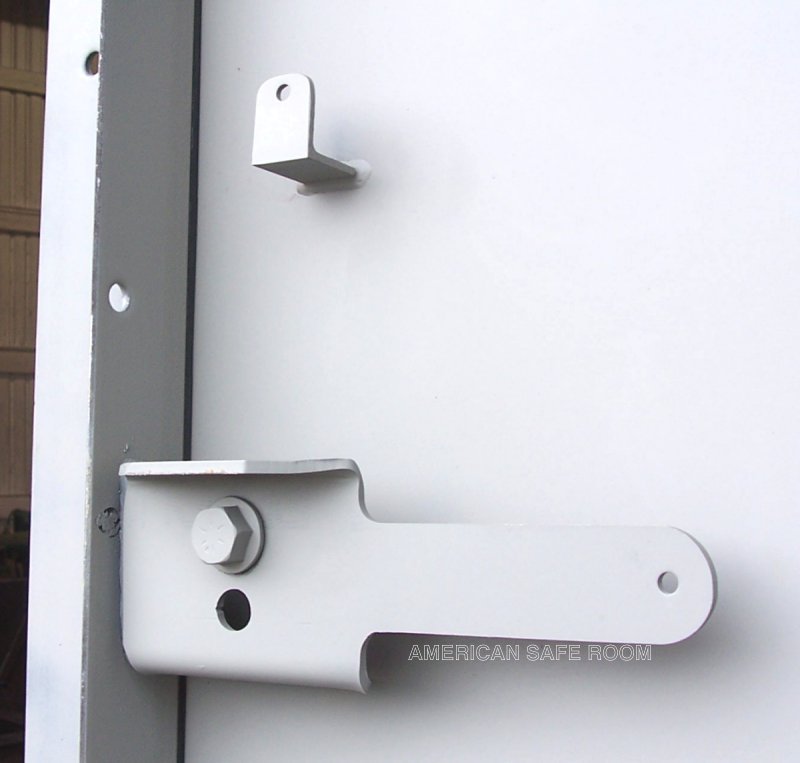 Cam latches
Cam latches
The cam latches are rotating handles on the inside of the door leaf that engage a cam welded on the frame. They operate in opposite directions in case the door is subject to violent movements by a detonation - one may loosen, but the other one will tighten, holding the door in place.
As you turn them, they draw the door leaf into the frame, compressing the door seal.
This picture shows the latch in the closed (latched) position. Note the bracket on the door leaf above the latch that allows you to lock your latches in the open position with a paddle lock. The hole in the bracket correspond with the hole in the cam latch handle.
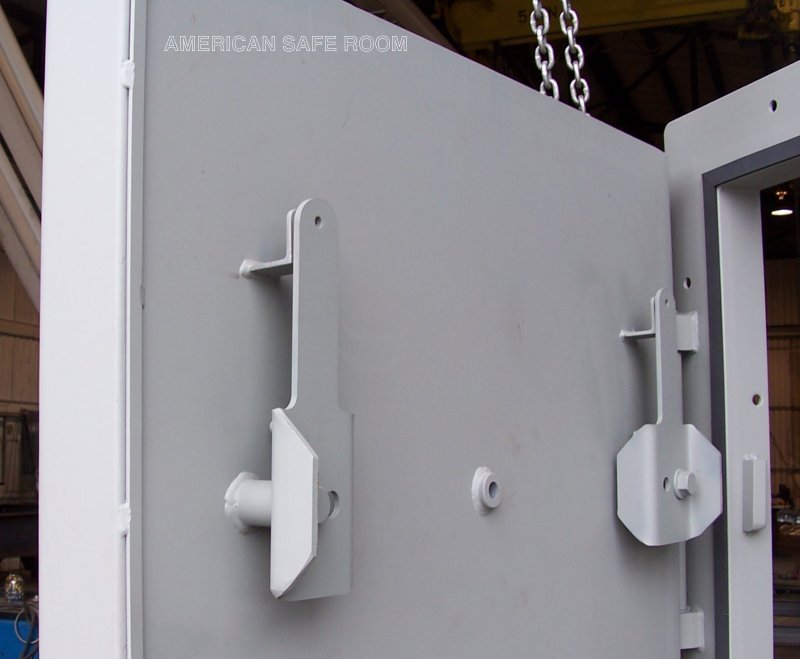 This picture shows the latches in the open (unlatched) position. They are positions over the brackets. Most machinery and large tools have a "lock out" function for maintenance. This duplicates that function in case you have to give someone access to your shelter who may try to lock you out.
We incorporated this feature on all of our blast doors after a customer with a teenager inquired about a way to ensure he was not locked out of his shelter.
This picture shows the latches in the open (unlatched) position. They are positions over the brackets. Most machinery and large tools have a "lock out" function for maintenance. This duplicates that function in case you have to give someone access to your shelter who may try to lock you out.
We incorporated this feature on all of our blast doors after a customer with a teenager inquired about a way to ensure he was not locked out of his shelter.
 Outside operators
Outside operators
On doors that require access from both sides, we install outside cam latch operators.
On the seated side of the door leaf, they operate just like our standard cam latches. One the unseated side, they have a handle that is on a shaft that goes through the door leaf and rotates the cam latch inside. We machine a steel barrel for the shaft to ride in. Each end of that barrel has an oil impregnated bronze bushing and there is a stainless steel grease fitting on the seated side. These outside operators are not suitable for bomb shelters or safe rooms, but they are quite popular with our industrial customers.
This is a 40 x 85 inch plate steel missile resistant door with outside operators and an inset deadbolt assembly that locks one of the operators in either the latched or unlatched position:
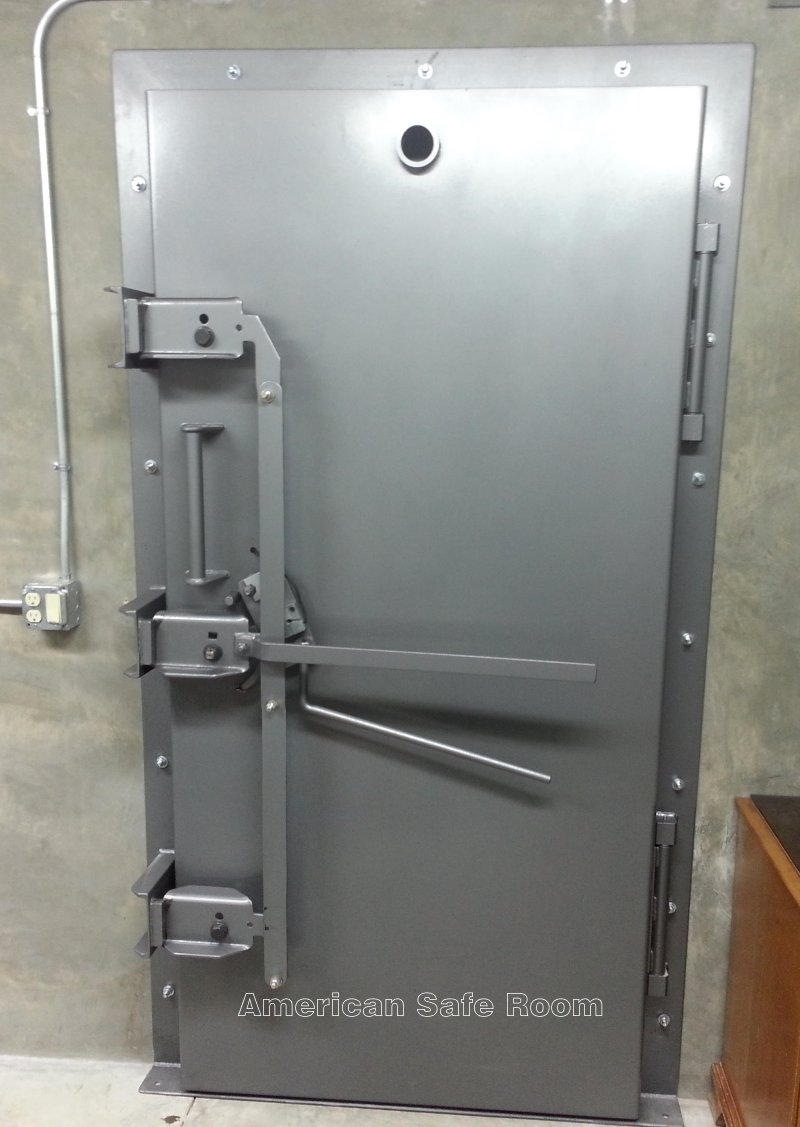 This is our response to the cheap ornimental doors being marketed as "vault doors" by internet marketing companies.
We used this lockworks on a couple of large plate steel doors that we built for Cyogenic test cells at Space X.
This is our response to the cheap ornimental doors being marketed as "vault doors" by internet marketing companies.
We used this lockworks on a couple of large plate steel doors that we built for Cyogenic test cells at Space X.
There are three rotating
latches that engage cams set into the frame. Each latch is rated for nearly 15,000 pounds. They are all operated by a single handle that has a shaft that runs through the door leaf. This shaft has a shear point in case the outside handle is forced in an attempt to breach the door.
There is an electronic keypad on the outside that has a wire connection to a deadbolt mounted on a floating hard plate in the inside. This hard plate is mechanically rotated out of engagement with the latches from the inside. This mechanical release prevents any possibility of being trapped inside due to electronic failure of the lock.
Be sure and see the short video of these lockworks in action below.
There is a complete presentation of these lockworks on our other website:
AamericanSafeRoom.com/blast-doors/safe-room-doors/
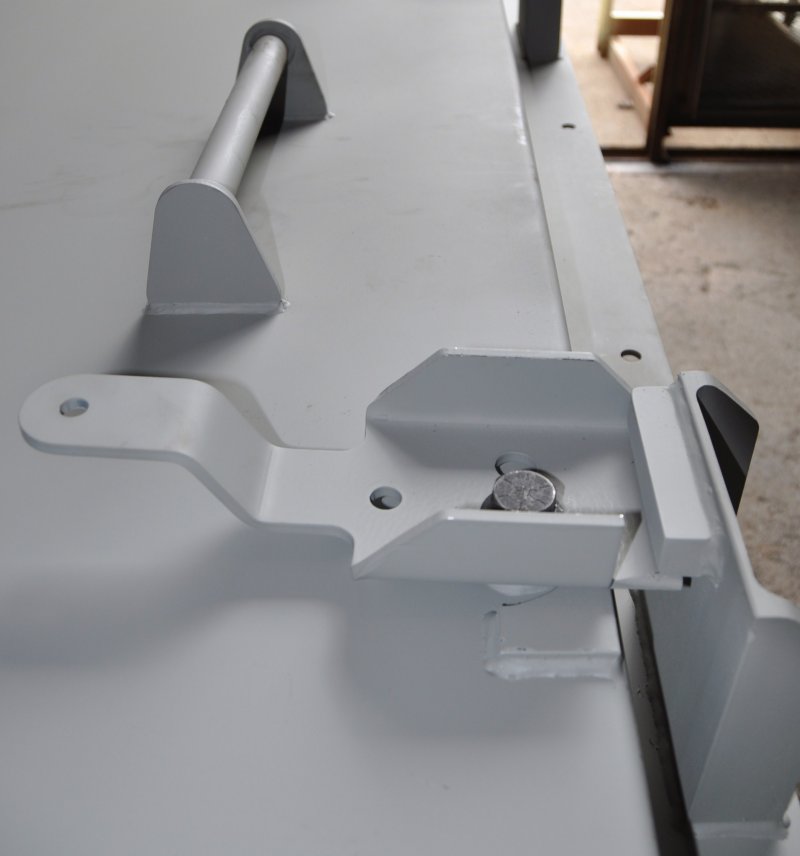 Inward swinging blast doors
Inward swinging blast doors
Blast doors normally open outward to carry the load in the seated condition. The blast load transfers directly from the door leaf to the frame and wall, not through the hinges and latches.
Certain installations require an inward swinging door and we offer it as an option. This is one of our cam latches secured shut on an inward swinging door.
We mount the cams on risers and widen the face flange of the frame. This picture shows an inward swinging door cam latch secured under the cam which is mounted on a riser to clear the door leaf thickness.
Professional engineer certified blast load calculations
Plate steel doors
Plate steel doors are fabricated from a single piece of steel. The hinges and latches are welded directly to the door leaf plate. On doors that require less than one inch of plate, we fabricate a frame to hold the plate flat out of structural steel tubing.
Fabricated steel doors
Very large doors or doors that have extreme blast loads can require a plate thickness that becomes weight and cost prohibitive. We engineer door leaves that are fabricated from wide flange beams with a steel skin on each side.
Calculations for plate and fabricated steel doors
Because the plate thickness and fabrication of these doors are driven by the blast load specifications, we engineer these doors to your specifications. We will quote the engineering and calculations separately from the doors. Contact our sales department to start the process.
See our custom blast door page for a gallery of doors that we have engineered and built.
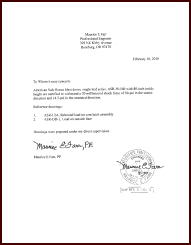 Concrete filled door leaves
Concrete filled door leaves
We have standard sizes and thicknesses for our concrete filled doors.
These doors are certified by a professional engineer to withstand a 50 PSI (3 bar)
blast load in the seated condition and 14.5 PSI (1 bar) rebound load in the unseated condition.
Sealing it all up - the door seal and threshold style
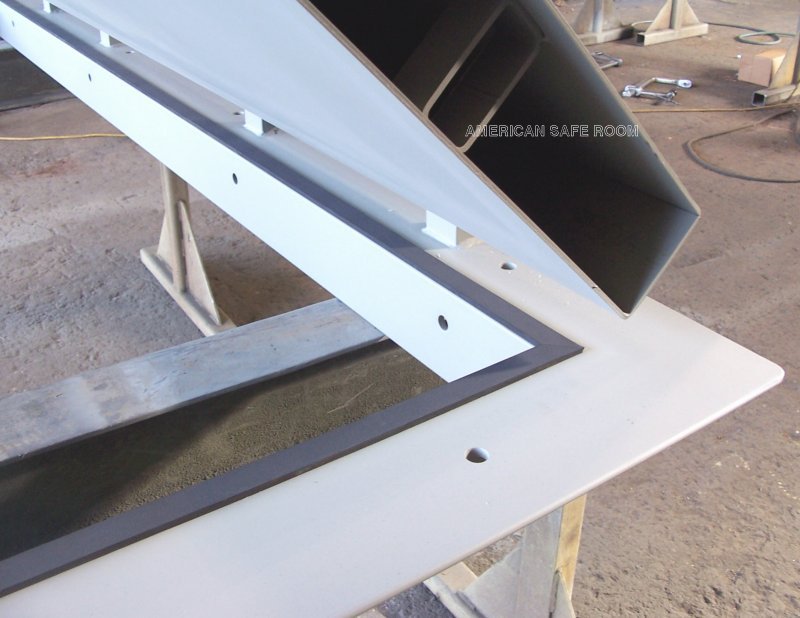 Compression seal
Compression seal
These doors features a synthetic rubber seal between the door and the frame allowing for the use of a positive pressure NBC filtration system inside the shelter. The inside cam latches draw the door into the seal as they are rotated. This puts the seal under compression between the door leaf and the frame. The strict tolerances we hold allow us to use a closed cell EPDM foam seal - not the bulb (automotive type) seal commonly used when manufacturers can't hold the tolerance necessary for a solid seal. This seal is expertly applied without stretching it and the corners are cleanly chamfered to seal out airborne toxins.
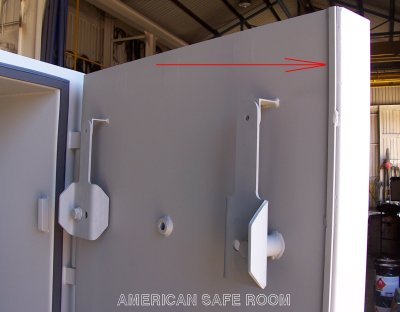 Steel on steel
Steel on steel
We stitch weld a piece of flat bar onto the
edge of the door leaf to ensure the door seal does not get over-compressed. This steel on steel dead stop keeps the door seal within the manufacturer's specifications for compression.
It's the attention to details like this that keeps our doors going for years in high duty-cycle industrial applications.
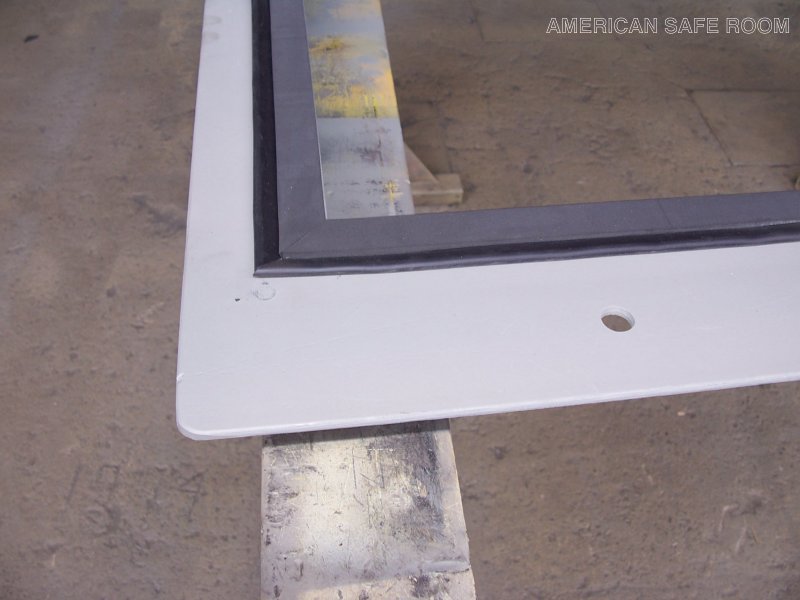 Fire rated door seal
Fire rated door seal
As an option, you can get a second, fire rated seal applied outside of the primary seal.
It is a 1/2” wide bulb seal that would have to fail before the main seal is compromised by a thermal event.
Tested in accordance with NFPA (National Fire Protection Association) standards 105 and 252, this seal also meet ASTM E283, E90, and E413. UL classified for use on hollow metal and steel-covered composite-style fire doors rated up to and including three hours. Meets UL 10B, UL 10C, and UL 1784.
 Threshold options
Threshold options
There are four different frame options to handle any type of threshold you have:
Flat threshold
Three inch concrete step over
Five inch concrete step over
Frame step over
This inward swinging door has a flat threshold with an adjustable sweep, a deadbolt lock, and an inset pull handle so that an outward swinging wooden door can be mounted over it to hide the shelter entrance.
Opening force
We asked one of our industrial customers that had a door installed in a FLEX building at a nuclear power generation plate in Missouri to test the force required to open a door. This particular door was a 36 by 80 inch door, but the thickness was sized to resist a certain spectra of missile threats. It featured a 5/16 inch skin thickness (compared to 1/4 inch on a normal door) and a 6.5/8 inch total door leaf thickness (compared to 4.3/8 inches on a normal door). The weight of the door leaf after filling was about 2,300 pounds (compared to about 1,700 pounds on a normal door). Here is their test results:
We did the test on the American Safe [Room] personnel doors that you requested. All testing was performed on the Plant South Door. We did the test 3 times and got consistent results on all 3 tests. There was no break away force needed to get the door swing started and the force was consistent throughout the travel to 45 degree OPEN. See below for equipment used and force observed:
Dillon Model GL Digital Force Gauge (0 – 100 lbs.)
M&TE number DYN2038MT
Cal. Due Date: 10/11/15
1. Unlatched door
2. Observed 20 pounds of initial force to OPEN door
3. Continued to apply 20 pounds of force through travel to 45 degree open
It took just 20 pound of force to open a 2,300 pound door!
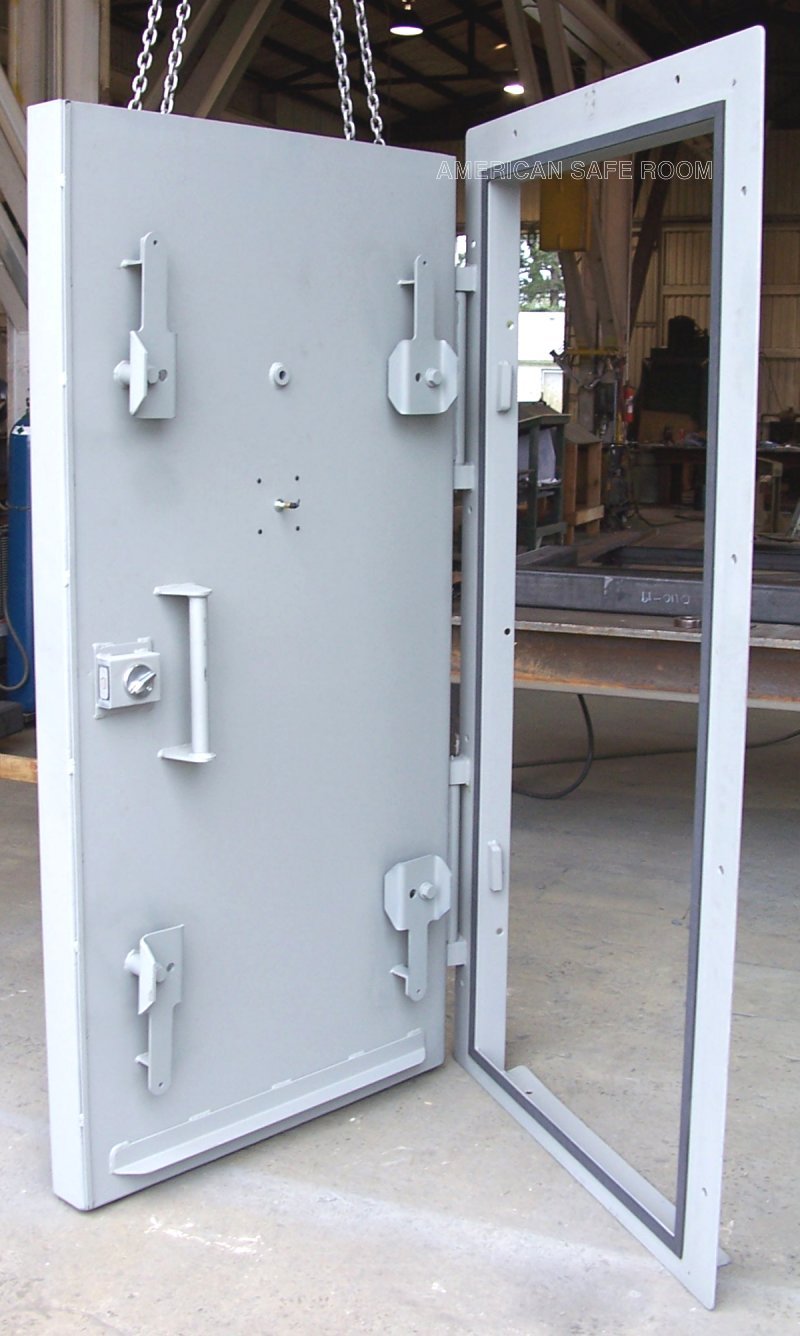 Sizes - standard and custom
Sizes - standard and custom
The standard sizes are 32 by 72 inches and 36 by 80 inches. These dimensions are the outside of the frame lips that insert into the opening in the wall. You need to make your wall opening a little larger that these dimensions - see the single leaf door manual for more information. We have built many custom sized doors. If you have an existing opening that needs a blast door, please contact us.
This is a 36 by 80 inch door with a bolt-on frame and a stepover threshold. It features assault resistant cam latches, a wide angle viewer, an inset deadbolt, and the differential pressure gauge will mount just below the viewer.
 Delivery
Delivery
The doors are shipped by LTL freight. We can specify that the delivery truck has a drop gate so the delivery is on the ground exactly where you want it. You must ensure that there is adequate turn around room.
Be sure and see this video showing the installation of a single leaf blast door:
Single leaf blast door installation
We've placed a lot of these doors in industrial applications: aerospace test cells, chemical plants, foundries, ordnance storage magazines, ordnance testing ranges, refuge chambers, and even a rhinoceros enclosure at a zoo. If you have an application that needs to protect from, or to contain a detonation, please contact our sales department at 541-459-1806 or sales@AmericanSafeRoom.com
Plate or fabricated doors:
Price quoted upon request
Complete price sheet of all items (PDF)
Door and hatch prices are on the second page
Concrete filled blast doors
Price, availability, and manual:
Options click on the item name to see the option
Telephone 541-459-1806 or e-mail
Click to enlarge
|

